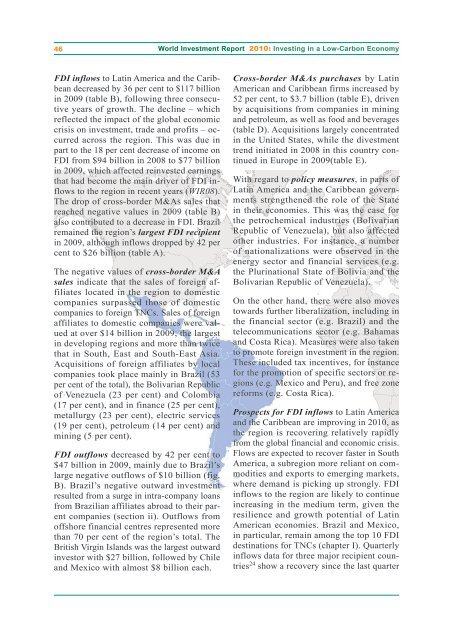UN World Investment Report 2010 - Office of Trade Negotiations
UN World Investment Report 2010 - Office of Trade Negotiations
UN World Investment Report 2010 - Office of Trade Negotiations
Create successful ePaper yourself
Turn your PDF publications into a flip-book with our unique Google optimized e-Paper software.
46<br />
FDI inflows to Latin America and the Caribbean<br />
decreased by 36 per cent to $117 billion<br />
in 2009 (table B), following three consecutive<br />
years <strong>of</strong> growth. The decline – which<br />
reflected the impact <strong>of</strong> the global economic<br />
crisis on investment, trade and pr<strong>of</strong>its – occurred<br />
across the region. This was due in<br />
part to the 18 per cent decrease <strong>of</strong> income on<br />
FDI from $94 billion in 2008 to $77 billion<br />
in 2009, which affected reinvested earnings<br />
that had become the main driver <strong>of</strong> FDI inflows<br />
to the region in recent years (WIR08).<br />
The drop <strong>of</strong> cross-border M&As sales that<br />
reached negative values in 2009 (table B)<br />
also contributed to a decrease in FDI. Brazil<br />
remained the region’s largest FDI recipient<br />
in 2009, although inflows dropped by 42 per<br />
cent to $26 billion (table A).<br />
The negative values <strong>of</strong> cross-border M&A<br />
sales indicate that the sales <strong>of</strong> foreign affiliates<br />
located in the region to domestic<br />
companies surpassed those <strong>of</strong> domestic<br />
companies to foreign TNCs. Sales <strong>of</strong> foreign<br />
affiliates to domestic companies were valued<br />
at over $14 billion in 2009, the largest<br />
in developing regions and more than twice<br />
that in South, East and South-East Asia.<br />
Acquisitions <strong>of</strong> foreign affiliates by local<br />
companies took place mainly in Brazil (53<br />
per cent <strong>of</strong> the total), the Bolivarian Republic<br />
<strong>of</strong> Venezuela (23 per cent) and Colombia<br />
(17 per cent), and in finance (25 per cent),<br />
metallurgy (23 per cent), electric services<br />
(19 per cent), petroleum (14 per cent) and<br />
mining (5 per cent).<br />
FDI outflows decreased by 42 per cent to<br />
$47 billion in 2009, mainly due to Brazil’s<br />
large negative outflows <strong>of</strong> $10 billion (fig.<br />
B). Brazil’s negative outward investment<br />
resulted from a surge in intra-company loans<br />
from Brazilian affiliates abroad to their parent<br />
companies (section ii). Outflows from<br />
<strong>of</strong>fshore financial centres represented more<br />
than 70 per cent <strong>of</strong> the region’s total. The<br />
British Virgin Islands was the largest outward<br />
investor with $27 billion, followed by Chile<br />
and Mexico with almost $8 billion each.<br />
<strong>World</strong> <strong>Investment</strong> <strong>Report</strong> <strong>2010</strong>: Investing in a Low-Carbon Economy<br />
Cross-border M&As purchases by Latin<br />
American and Caribbean firms increased by<br />
52 per cent, to $3.7 billion (table E), driven<br />
by acquisitions from companies in mining<br />
and petroleum, as well as food and beverages<br />
(table D). Acquisitions largely concentrated<br />
in the United States, while the divestment<br />
trend initiated in 2008 in this country continued<br />
in Europe in 2009(table E).<br />
With regard to policy measures, in parts <strong>of</strong><br />
Latin America and the Caribbean governments<br />
strengthened the role <strong>of</strong> the State<br />
in their economies. This was the case for<br />
the petrochemical industries (Bolivarian<br />
Republic <strong>of</strong> Venezuela), but also affected<br />
other industries. For instance, a number<br />
<strong>of</strong> nationalizations were observed in the<br />
energy sector and financial services (e.g.<br />
the Plurinational State <strong>of</strong> Bolivia and the<br />
Bolivarian Republic <strong>of</strong> Venezuela).<br />
On the other hand, there were also moves<br />
towards further liberalization, including in<br />
the financial sector (e.g. Brazil) and the<br />
telecommunications sector (e.g. Bahamas<br />
and Costa Rica). Measures were also taken<br />
to promote foreign investment in the region.<br />
These included tax incentives, for instance<br />
for the promotion <strong>of</strong> specific sectors or regions<br />
(e.g. Mexico and Peru), and free zone<br />
reforms (e.g. Costa Rica).<br />
Prospects for FDI inflows to Latin America<br />
and the Caribbean are improving in <strong>2010</strong>, as<br />
the region is recovering relatively rapidly<br />
from the global financial and economic crisis.<br />
Flows are expected to recover faster in South<br />
America, a subregion more reliant on commodities<br />
and exports to emerging markets,<br />
where demand is picking up strongly. FDI<br />
inflows to the region are likely to continue<br />
increasing in the medium term, given the<br />
resilience and growth potential <strong>of</strong> Latin<br />
American economies. Brazil and Mexico,<br />
in particular, remain among the top 10 FDI<br />
destinations for TNCs (chapter I). Quarterly<br />
inflows data for three major recipient countries<br />
24 show a recovery since the last quarter

















